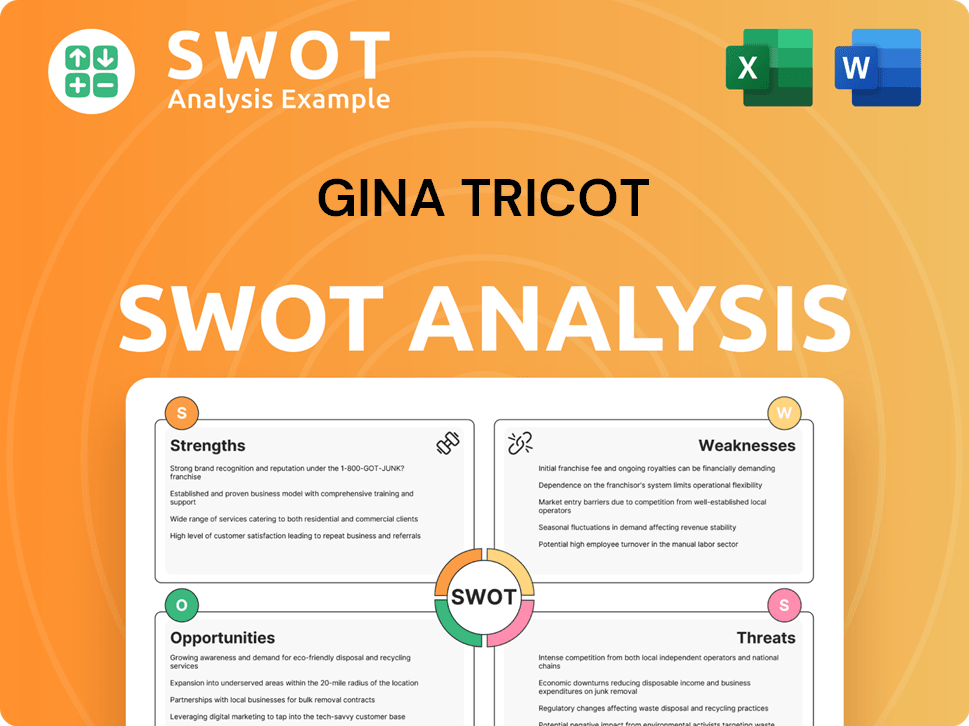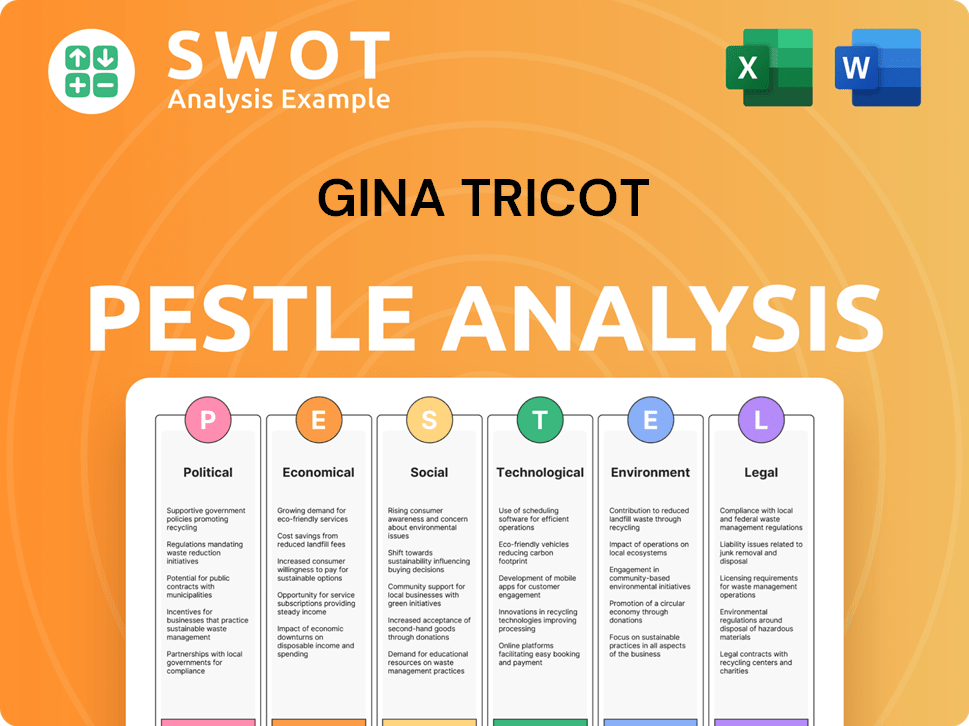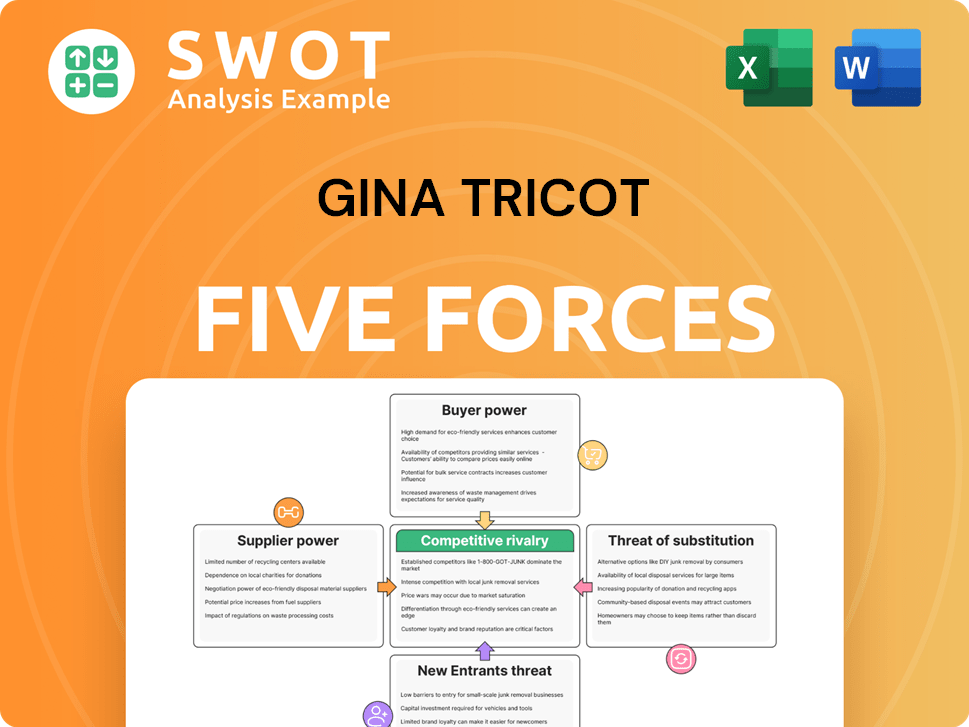Gina Tricot Bundle
Can Gina Tricot Conquer the Future of Fashion?
In the fast-paced world of fashion retail, staying ahead requires more than just trendy designs; it demands a dynamic Gina Tricot SWOT Analysis. This analysis delves into the core of Gina Tricot's operations, exploring its strategic initiatives and potential for expansion. We will examine how this Swedish fashion chain is navigating the evolving retail landscape.

This exploration of the Gina Tricot growth strategy examines its potential in the competitive fashion retail market. Understanding the Gina Tricot future prospects involves analyzing its strategic goals and objectives within the Swedish fashion industry. The company's ability to adapt and innovate will be key to its success, especially considering factors like online sales strategy and the impact of fast fashion.
How Is Gina Tricot Expanding Its Reach?
The Gina Tricot growth strategy centers on strategic expansion, targeting both geographical reach and product diversification. Historically rooted in the Nordic market, the company is actively exploring international opportunities, particularly within Europe. This approach aims to access new customer bases and diversify revenue streams, focusing on markets with high demand for affordable women's wear.
Beyond geographical expansion, the company is broadening its product categories. While primarily known for fast fashion apparel, Gina Tricot is investing in more sustainable collections and exploring complementary product lines like accessories. This diversification aligns with evolving consumer preferences, especially the growing demand for sustainable fashion. Partnerships with sustainable material suppliers and brand collaborations are key components of this strategy.
The company has set an ambitious goal regarding sustainability. By 2025, Gina Tricot aims to have 100% of its products made from more sustainable materials, reflecting a strong commitment to environmental responsibility. This commitment is a key element of their future prospects and brand positioning within the fashion retail market.
Gina Tricot is focusing on expanding its presence in key European markets. This includes identifying countries with strong demand for affordable fashion and establishing both online and physical retail presence. The strategy involves a blend of e-commerce and strategic store openings to maximize market penetration.
The company is diversifying its product range beyond apparel. This includes expanding into accessories and lifestyle items to cater to a broader customer base. Emphasis is placed on sustainable collections to meet the growing demand for eco-friendly fashion choices.
Gina Tricot is committed to sustainability, with the goal of having all products made from sustainable materials by 2025. This includes sourcing sustainable materials and implementing eco-friendly production processes. This initiative is crucial for brand image and future growth.
The company is strengthening its online sales strategy. This involves enhancing the e-commerce platform to improve the customer experience and drive sales. Digital marketing and social media engagement are key components of this strategy.
Gina Tricot's strategic goals include expanding its geographical footprint, diversifying its product offerings, and enhancing its sustainability efforts. These goals are designed to drive long-term growth and strengthen its position in the competitive fashion retail market. The company is focused on adapting to changing consumer preferences and market trends.
- Increase international market share.
- Expand product lines to include sustainable and lifestyle items.
- Achieve 100% sustainable materials in all products by 2025.
- Enhance e-commerce capabilities and customer experience.
Gina Tricot SWOT Analysis
- Complete SWOT Breakdown
- Fully Customizable
- Editable in Excel & Word
- Professional Formatting
- Investor-Ready Format

How Does Gina Tricot Invest in Innovation?
The growth strategy of the company is significantly shaped by its embrace of innovation and technology. This approach is crucial for enhancing customer experience, streamlining operations, and promoting sustainability, all key aspects of its long-term vision. The company's strategic focus on digital transformation, particularly in its e-commerce platform, underscores its commitment to adapting to evolving consumer behaviors and market trends.
The company's innovation strategy is multifaceted, involving investments in various technologies to improve efficiency and customer engagement. This includes leveraging data analytics for targeted marketing and product recommendations, as well as exploring AI for inventory management and trend forecasting. The company's approach to technology is not just about adopting new tools but also about integrating them strategically to create a more responsive and efficient business model. This is a key element of the company's overall growth strategy.
Sustainability is another core pillar of the company's innovation strategy, reflecting a growing consumer preference for environmentally responsible brands. By focusing on sustainable materials, production processes, and circular fashion models, the company aims to align its business practices with ethical considerations and consumer expectations. This commitment to sustainability is a key driver of its future prospects, positioning it favorably in the evolving fashion retail market.
The company continuously invests in its e-commerce platform to provide a seamless and personalized online shopping experience. This involves using data analytics to understand customer behavior and tailor marketing campaigns. The focus is on improving user experience and driving online sales, a critical component of the company's growth.
The company explores integrating AI for inventory management and trend forecasting. Data analytics are used to understand customer preferences and optimize product offerings. This technology-driven approach aims to reduce waste and improve supply chain efficiency.
Automation is a key area of focus to expedite order fulfillment and reduce operational costs. This includes implementing automated systems in warehousing and logistics. The goal is to streamline processes and improve the efficiency of the supply chain.
The company is dedicated to sustainability initiatives, viewing them as an ethical imperative and a strategic growth driver. Investments are made in sustainable materials, production processes, and circular fashion models. The company aims to have 100% of its products made from more sustainable materials by 2025.
The company is exploring textile recycling programs as part of its circular fashion initiatives. This involves finding innovative solutions to reduce waste and promote sustainability. Textile recycling is a key component of its commitment to environmental responsibility.
The company focuses on optimizing its supply chain to improve efficiency and reduce environmental impact. This includes sourcing sustainable materials and implementing efficient production processes. Supply chain optimization is a critical element of its overall sustainability strategy.
The company's strategic goals and objectives are closely tied to its innovation and technology strategy. By focusing on these areas, the company aims to enhance its competitive position in the fashion retail market. The company's digital transformation efforts, combined with its sustainability initiatives, are designed to meet evolving consumer demands and drive long-term growth. For more insights into the company's history, you can read a Brief History of Gina Tricot.
The company's approach integrates technology and innovation to enhance customer experience, optimize operations, and promote sustainability. This includes a strong focus on e-commerce, data analytics, AI, and automation. The company's strategic goals and objectives are centered around these key areas, driving its future prospects in the fashion retail market.
- Continuous investment in e-commerce for a seamless and personalized online shopping experience.
- Use of data analytics to understand customer behavior and tailor marketing campaigns.
- Exploration of AI for inventory management and trend forecasting to reduce waste.
- Automation in warehousing and logistics to expedite order fulfillment and reduce costs.
- Commitment to sustainability through sustainable materials and circular fashion models. The company aims to have 100% of its products made from more sustainable materials by 2025.
Gina Tricot PESTLE Analysis
- Covers All 6 PESTLE Categories
- No Research Needed – Save Hours of Work
- Built by Experts, Trusted by Consultants
- Instant Download, Ready to Use
- 100% Editable, Fully Customizable

What Is Gina Tricot’s Growth Forecast?
The financial outlook for Gina Tricot is shaped by its strategic goals, focusing on sustainable profitability and expanding market share. While specific financial details for 2024-2025 aren't publicly available, the company's strategies suggest a positive direction. The fashion retail market is competitive, but Gina Tricot's focus on key areas is expected to drive growth.
Gina Tricot reported a net turnover of SEK 2.0 billion for the 2022/2023 financial year, demonstrating a solid base for future expansion. This performance supports the company's ability to invest in growth initiatives. The Swedish fashion industry, where Gina Tricot operates, is dynamic, requiring continuous adaptation and innovation.
The company's financial strategy involves investing in e-commerce and international expansion. Investments in technology and sustainable practices are expected to improve operational efficiency and potentially enhance brand value. Funding for these initiatives likely comes from retained earnings and potentially external financing. The financial narrative emphasizes prudent investment in growth areas, leveraging its market position to capitalize on opportunities while maintaining financial stability. For a deeper dive into the company's ownership structure, you can explore Owners & Shareholders of Gina Tricot.
Gina Tricot's online sales strategy is crucial for revenue growth. The company focuses on enhancing its e-commerce platform and digital marketing to reach a wider audience. E-commerce is a key area for expansion, allowing the company to reach customers globally.
International expansion is a primary focus for Gina Tricot's growth strategy. The company aims to increase its presence in existing markets and enter new ones. This expansion is expected to contribute significantly to overall revenue and market share.
Sustainability is a key element of Gina Tricot's brand positioning. The company is investing in sustainable practices across its supply chain and operations. These initiatives aim to enhance brand value and attract environmentally conscious consumers.
The financial performance review of Gina Tricot indicates a focus on sustainable profitability. The company's ability to manage costs and generate revenue growth is critical. This includes careful management of profit margins and operational efficiency.
Gina Tricot's strategic goals and objectives include increasing market share and enhancing brand value. The company's focus is on sustainable growth and adapting to the evolving fashion retail market. Key objectives include:
- Expanding e-commerce capabilities.
- Increasing international presence.
- Implementing sustainable practices.
- Improving operational efficiency.
Gina Tricot Business Model Canvas
- Complete 9-Block Business Model Canvas
- Effortlessly Communicate Your Business Strategy
- Investor-Ready BMC Format
- 100% Editable and Customizable
- Clear and Structured Layout

What Risks Could Slow Gina Tricot’s Growth?
The growth trajectory of Gina Tricot faces several potential risks and obstacles, particularly in the highly competitive fashion retail market. These challenges span from intense market competition to the need to adapt to rapidly changing consumer preferences and technological advancements. Understanding and proactively addressing these risks is crucial for the company to sustain its growth and achieve its strategic objectives.
The fast fashion industry is characterized by its dynamic nature, requiring companies to be agile and responsive. Gina Tricot must navigate a complex landscape, including supply chain vulnerabilities and evolving regulatory demands, to maintain its market position. The success of Gina Tricot's future prospects hinges on its ability to mitigate these risks effectively through strategic planning and operational excellence.
The company's strategic focus on sustainability and digital innovation is essential for long-term success. However, the execution of these strategies also presents potential risks. For instance, failure to effectively manage e-commerce platforms or adapt to new sustainability regulations could hinder growth. The company's ability to attract and retain talent is also a critical factor in its ability to innovate and expand.
The fashion retail market is highly competitive, with numerous global and online retailers vying for market share. This intense competition can lead to price wars, reduced profit margins, and increased pressure on marketing budgets. To stay competitive, Gina Tricot must continually innovate its product offerings and enhance its brand positioning.
The fashion industry faces a rapidly changing regulatory landscape, particularly concerning sustainability and labor practices. Stricter regulations could increase operational costs and require significant adjustments to supply chain management. Compliance with these regulations is essential for maintaining consumer trust and avoiding legal penalties.
Supply chain disruptions, whether from geopolitical events, natural disasters, or increased raw material costs, pose a constant threat. These disruptions can impact inventory management and timely product delivery, affecting sales and customer satisfaction. Diversifying the supply chain and implementing robust risk management frameworks are crucial.
The rapid pace of technological advancements presents both opportunities and risks. Failure to keep pace with digital advancements or protect e-commerce platforms from cyber threats could hinder growth. Investing in technology and cybersecurity is essential for maintaining a competitive edge in the online retail space.
Attracting and retaining skilled talent in a competitive job market can be challenging. Internal resource constraints may hinder innovation and expansion efforts. Investing in employee development and creating a positive work environment are important for retaining top talent.
E-commerce faces challenges such as increasing competition from online retailers and managing customer expectations. The company should focus on improving website user experience and optimizing online sales strategies. The article Marketing Strategy of Gina Tricot provides deeper insights.
In 2024, the Swedish fashion industry saw significant shifts in market share, with online sales continuing to rise. For example, H&M reported a revenue of approximately $23.6 billion. Gina Tricot's financial performance will depend on its ability to adapt to these market dynamics and enhance its online presence. The company must navigate a competitive landscape and manage operational costs.
Sustainability initiatives are becoming increasingly important in the fashion industry. Companies are under pressure to reduce their environmental impact and improve labor practices. Supply chain disruptions, such as those caused by the COVID-19 pandemic, have highlighted the need for diversified supply chains and robust risk management frameworks. These factors are crucial for long-term success.
Gina Tricot Porter's Five Forces Analysis
- Covers All 5 Competitive Forces in Detail
- Structured for Consultants, Students, and Founders
- 100% Editable in Microsoft Word & Excel
- Instant Digital Download – Use Immediately
- Compatible with Mac & PC – Fully Unlocked

Related Blogs
- What are Mission Vision & Core Values of Gina Tricot Company?
- What is Competitive Landscape of Gina Tricot Company?
- How Does Gina Tricot Company Work?
- What is Sales and Marketing Strategy of Gina Tricot Company?
- What is Brief History of Gina Tricot Company?
- Who Owns Gina Tricot Company?
- What is Customer Demographics and Target Market of Gina Tricot Company?
Disclaimer
All information, articles, and product details provided on this website are for general informational and educational purposes only. We do not claim any ownership over, nor do we intend to infringe upon, any trademarks, copyrights, logos, brand names, or other intellectual property mentioned or depicted on this site. Such intellectual property remains the property of its respective owners, and any references here are made solely for identification or informational purposes, without implying any affiliation, endorsement, or partnership.
We make no representations or warranties, express or implied, regarding the accuracy, completeness, or suitability of any content or products presented. Nothing on this website should be construed as legal, tax, investment, financial, medical, or other professional advice. In addition, no part of this site—including articles or product references—constitutes a solicitation, recommendation, endorsement, advertisement, or offer to buy or sell any securities, franchises, or other financial instruments, particularly in jurisdictions where such activity would be unlawful.
All content is of a general nature and may not address the specific circumstances of any individual or entity. It is not a substitute for professional advice or services. Any actions you take based on the information provided here are strictly at your own risk. You accept full responsibility for any decisions or outcomes arising from your use of this website and agree to release us from any liability in connection with your use of, or reliance upon, the content or products found herein.